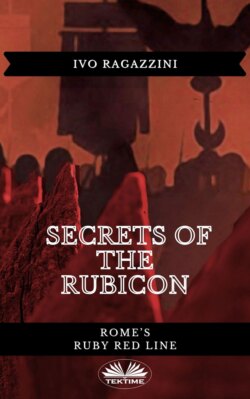Читать книгу Secrets Of The Rubicon - Ivo Ragazzini - Страница 4
Preface
ОглавлениеOnce upon a time, on the way to Rome, there was a land that was traversed and defended by the Romans as a sacred, impassable border.
That land was formerly called Flaminia, it was then renamed Romagna for reasons that you will soon discover for yourself.
Today that sacred and impenetrable border, protected by the Gods of Rome, is no longer, but it existed then and many events occurred around there.
At that time the Romans knew very well what that border was and why they had built it, but from the Middle Ages until today, no one knew where it really was and many have tried to find it.
But there was no unified search and three or four conflicting theories have arisen regarding its location.
But where did that border go? And mostly, what really happened there?
Today, and for centuries, many have continued to ask themselves this question. Occasionally various societies and academies have gathered together in argumentative meetings to decide, now in favor of one place, now in favor of another.
But to questions such as:
For who and why was that border built the first time?
Why and how was it built?
Why did the Romans call it Puniceus Rubicon?
Why were there red sands that no longer exist today?
Was there a place called 'Malanotte' (Dreadful night) on the banks of that border?
Did Caesar and many Roman legionaries have nightmares or a Malanotte before crossing that border?
It seems that no one has tried to answer these and many other questions.
And that is shame, because it would have led to discovering a few answers and much more about what the Rubicon was, and what it was for, which would have led to discovering why and who had built that border, plus many other novelties that you will discover for yourself while reading.
Briefly, we have been discussing and researching the location of the Rubicon for centuries, but before finding the location of this border, many failed to discover what it was for and who and why built it the first time before Caesar was even born.
And if anyone had investigated these things thoroughly, I am convinced they would inevitably have discovered this and more.
I only add that this book, is not a rehashing of other works, and will lead you to discover many other mysteries and stories about the history of Rome, the Rubicon and ancient Romagna for the first time that you may never have suspected.
Straddling somewhere between an essay and historical account, the way is opened through twenty centuries of history and paths that have never been travelled before. This book is based on historical research, forgotten local legends, etymological research and observations that have never been made before. For the first time, light is shed on the darkness of those disputed events on the ruby-red border named the Rubicon. A unique story has been created that refers to nothing that has been written previously on the subject.
In particular, this book will answer the following questions for the first time:
What really was the Rubicon?
Why was it given that name?
Who for and why was the border created long before Caesar?
What was Romagna at the time?
What were the symbols and insignia used by Caesar's Gallic legions?
What insults did the Roman legionaries and warriors of that time shout?
What was the New Year's feast at the time of Caesar?
Why did Caesar cross the Rubicon immediately after the New Year's elections?
And, to tell the truth, many other things that you may never have guessed at, in a crescendo of facts and revelations that will reveal many facts and places that have been forgotten by history during that turbulent period of transition from republic to the Roman Empire.
So, enjoy reading and rediscovering the history of the Rubicon as well as many other facts.
